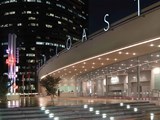by Brian Robin
Stage Design 101-Starring Tom Buderwitz
The task facing Tom Buderwitz when he took over scenic design for A Christmas Carol in 2002 was challenging and counterintuitive. Come in and give the sets for SCR’s holiday tradition a facelift. But don’t do it all at once.
“I couldn’t just change everything in one fell swoop. It had to be integrated over a period of years,” said Buderwitz, who inherited Cliff Faulkner’s original design. “We did it over six years in parts and it all had to work with the existing show. Our schedule didn’t allow for a lot of tech time and there wasn’t a lot of money. That was the challenge: integrating new things into the existing production and make them feel integrated and let the production change over the course of the next decade.”
First, came the front of the proscenium, redoing the Gustave Doré drawings of Victorian London seen on the stage panels. The drawings were resized and rescaled. In Year 2 (2003), Buderwitz tackled Scrooge’s bedroom. The next year, it was Scrooge’s Counting House’s turn. Then, a revision of the Cratchits’ house, cutting down a wall and adding the roof.
Now, his work on A Christmas Carol’s set is more fine-tuning, mostly props and smaller set adjustments. But the award-winning stage designer never stops seeing the Segerstrom Stage as Charles Dickens’ playground.
“A Christmas Carol is always a work in progress. There are different variations and we’re always re-addressing things every year,” he said. “It’s really fun this year with the change in cast. … We’ve addressed most of the major things, but we’re always looking at everything. Will this still work? It this still playing right? With the blocking changes that come with new cast members, you may want to make a change as simple as positioning a chair differently. It’s always a fun thing to work on.”
For Buderwitz, the fun part is researching to find the right look to match the period and setting. The challenge comes with the “little axiom” Buderwitz took from his student days at Adelphi University on Long Island. Three words that guide everything Buderwitz does.
“The main challenge to me is form follows function. It means what it looks like has to come after how it functions,” he said. “If it can’t function, it doesn’t matter what it looks like. It’s always about trying to get functionality on stage. Is there enough space for the actors? Where do they move? Where does the furniture go? How do the sightlines work? Does it make sense for characters to get from one place to the other in terms of a multi-set show? That’s always the hardest part. After I solve the function, then I can have fun.”
Buderwitz is no stranger to SCR. He designed sets for Outside Mullingar, The Monster Builder, The Whipping Man, The Whale, The Prince of Atlantis, The Trip to Bountiful, Three Days of Rain, The Weir, Crimes of the Heart, The Heiress and A Delicate Balance, among others. He co-designed the set for Tartuffe with director Dominique Serrand.
Buderwitz is also no stranger to awards. He earned three Emmy nominations for television design. His mantle already contains six Los Angeles Stage Alliance Ovation Awards and three Los Angeles Drama Critics Circle Awards.
“I love the fact I got involved in this production and seeing how great the longevity has been,” he said. “Seeing how it wows Orange County audiences all these years is a great feeling. I always like coming home and rejoining the SCR family on A Christmas Carol. It’s a special feeling getting it back on its feet every year.”


